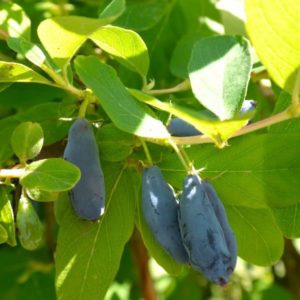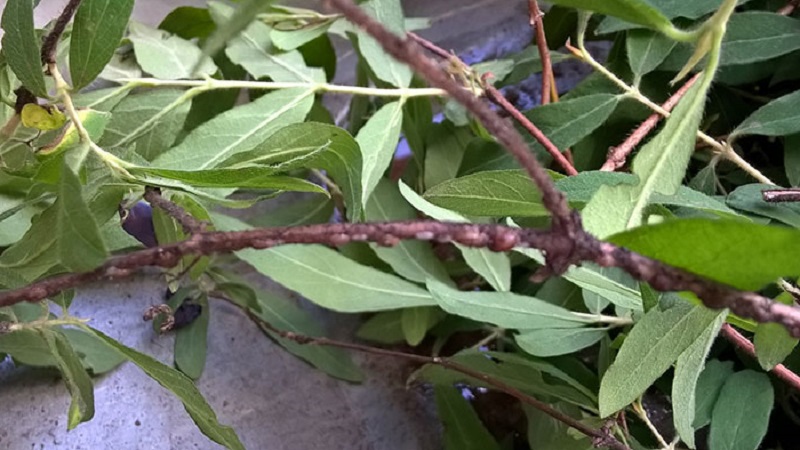Early fruiting variety of honeysuckle Viola
Not every gardener grows honeysuckle, but gradually this crop is becoming more and more popular. It attracts with its decorative shrub, taste of berries and unpretentiousness. Cultivated varieties, for example, Viola honeysuckle, are absolutely not difficult to grow. Caring for it is very simple, but it has its own characteristics that are important to know.
Description of the honeysuckle variety Viola
Viola is a fast-growing variety. The berries are large (about 1.2 g) with a bumpy surface, which are shaped like elongated barrels.
Origin and development
The culture was obtained by crossing the Leningradsky Giant and Sayanskaya 322 varieties. It was bred by breeders A.V. Kondrikova and M.N. Plekhanova at the Pavlovsk experimental station of the VNIIR. Viola was added to the State Register in 1995.
Characteristics, description of appearance, taste

An adult plant has powerful, developed branches and a dense, squat, oval-shaped crown. The bush grows to about 2 m in height, and its diameter reaches 2.5 m.
Old shoots have brown-red bark. Young branches are erect and thin, light green in color, without pubescence.
The leaf blades are large and dark green in color. They are slightly concave along the central vein and have a bluish coating on the underside.
The berries are dark blue or purple with a thick skin. They have a characteristic waxy coating. The pulp of the fruit is sweet and sour with a slight bitterness and a fresh aftertaste.
Features of application
The berries of the Viola variety are consumed fresh, although they are slightly bitter. They are also used for making wine, preserves, jam, compote and a variety of desserts. During heat treatment, the fruits almost do not lose their useful qualities.
Productivity and fruiting
Fruiting in Viola honeysuckle is consistent, the berries ripen at the same time. With proper care, about 3-4 kg of fruits are harvested from an adult bush.
Ripening period
This is a fast-growing variety. The berries are ready for picking in early June.
Resistance to diseases and pests
Viola has good immunity to diseases and is resistant to pests. But in order for the bush to be healthy and produce good yields, preventive spraying is carried out periodically.
Resistance to cold and drought
The Viola variety has average resistance to cold. It can withstand frosts down to -30°C with the root circle covered.
The crop does not tolerate drought well. It is important to monitor the soil moisture, but you should not over-moisten it so as not to provoke the occurrence of fungal diseases.
Suitable regions and climate requirements
Viola honeysuckle feels most comfortable in the northwestern regions, since it was for them that the variety was bred. The crop also showed good productivity in the Moscow region and Ukraine. There, the berries ripen about a week later without loss of large fruit and yield.
Important! Honeysuckle does not like the climate of the steppes with dry air.
Advantages and disadvantages
The main advantages of honeysuckle Viola:
- early ripening;

- stable fruiting;
- good resistance to diseases and harmful insects;
- ripe berries do not fall off the bush for a long time;
- high decorative qualities, due to which the crop is often used to decorate personal plots;
- unpretentiousness.
Among the disadvantages are:
- presence of bitterness in taste;
- insufficient sweetness;
- average winter hardiness;
- high demands on air humidity and regularity of watering.
Difference from other varieties and hybrids
The peculiarity is a slight bitterness in taste. Most edible varieties of honeysuckle do not have it.
Agricultural technology
The plant requires care throughout the growing season. It starts with landing. The further development of the plant and its productivity depend on the correctness of the procedure.
Choosing a place in the garden and preparing holes
This variety of honeysuckle grows best in partial shade.. It is advisable that the planting site be located near buildings or tall trees that will protect the plant from direct sunlight.
Before planting, prepare the holes. Their depth and diameter should be about 50 cm. During digging, the top layer of earth is thrown into a separate pile.
Fill the holes with 2 buckets of humus or compost, 1 liter jar of ash and add 1 tbsp. l. superphosphate. All this is mixed with the top layer of soil.
Preparation for planting and soil requirements
Before planting, the roots of the seedlings are dipped in a growth stimulator. The duration of soaking is indicated on the product packaging.
The most suitable soil for the variety is chernozem, slightly acidic.
Dates, scheme and rules of planting

The shrub is planted or replanted in the autumn, but no later than mid-November. There should be 3-4 weeks left before frost arrives. During this period, the vegetative processes in the plant begin to slow down, due to which the survival rate increases. It is not advisable to plant honeysuckle in spring, since this crop awakens very early.
Landing is carried out as follows:
- A bucket of water is poured into the prepared planting holes.Wait until it is absorbed.
- The roots of the seedling are straightened and placed in the middle of the hole.
- Covered with earth.
- The soil around the seedling is mulched with sawdust, pine needles, peat, humus, etc.
The minimum distance between plants is 1.5 m. This is required so that they have enough moisture and nutrients when the bushes grow green. If you do not keep the distance, the berries will gradually become small, productivity will decrease.
Important! After planting, the shoots are not pruned. It is advisable to injure them as little as possible in order to speed up rooting.
Features of cultivation
In hot and dry weather, honeysuckle must be watered. Otherwise, the bitterness in the berries will increase. 10-20 liters of water are poured under each plant. Watering frequency – 1-2 times a week. If the weather is rainy, honeysuckle is not watered.
Viola is fed not with mineral fertilizers, but with organic matter. This honeysuckle requires little fertilizer. At the beginning of spring, it is enough to pour 1 liter jar of wood ash and 1 bucket of humus under each bush. This is enough to form a large number of large berries.
The variety quickly grows new shoots. Soon he begins to occupy the entire territory allotted to him. Pruning is carried out 3 years after planting. The procedure is performed in early spring or autumn, when all the leaves have fallen off. Cut off damaged and dry shoots. Also remove branches that grow inside the bush, as they will thicken it.
Pollinators
This variety needs pollinators. It is advisable to have at least 3 different varieties of honeysuckle on the site, but with the same flowering period. They are planted next to each other.
For Viola, the best pollinators are considered Blue spindle, Morena, Nymph, Amphora, In Memory of Gidzyuk, Pavlovskaya.
Disease and pest control

The crop is sometimes affected by fungal diseases. Treatment and prevention are carried out by spraying the bushes with a solution of copper sulfate. 100 g of the substance are dissolved in a bucket of water.
Of the pests, the variety is affected by aphids, scale insect and honeysuckle mites. When attacked by aphids, the leaves begin to curl. Scale insects usually live on shoots, damaging the bark. If mites are present, dark growths appear on the lower part of the leaf blade. Pests destroyed using the drugs “Rogor”, “Omite”, “Aktara”, “Elexar” or “Mavrik”. The products are diluted in accordance with the instructions. Complete destruction usually requires 2 treatments.
Preparing for winter
Honeysuckle is prepared for winter after pruning. The branches are not covered, as they are usually not damaged by frost. Mulch the root circle to prevent the root system from freezing. To do this, use pine needles, straw, hay or leaves. The mulch layer should be at least 5 cm.
Reproduction
Cuttings are used for propagation. They are cut from last year's shoots after the ovaries appear on the bush. Then they are planted in a greenhouse in a substrate consisting of sand and peat in a ratio of 3 to 1. The most suitable temperature for rooting is +20°C.
Honeysuckle seedlings are ready for transplanting in the fall. They are planted using the transshipment method, that is, while preserving the earthen clod. This reduces the risk of injury to the root system.
Difficulties in growing
Difficulties arise when grown in very cold regions, such as Siberia. In this case, the tree trunk circle is mulched with a layer of 10 cm, and the shoots are covered with agrofibre. But sometimes this is not enough. There remains a possibility that the plant will die during a harsh winter.
Harvesting
It is best to use plastic containers for collection. In one such container they collect 1-1.5 kg, no more. Otherwise, the berries will choke.
The harvest is harvested in early June. Harvesting is done by hand, as the berries fall off the bushes poorly.
Tips and reviews from experienced gardeners
Summer residents note the variety’s unpretentiousness, high yield and taste, as well as decorative properties.
Olga, Kaliningrad: “I like Viola honeysuckle for its interesting taste and high yield. Besides, she is very beautiful. Five years ago I planted several bushes. Now they decorate the yard from spring until late autumn, until the leaves fall. The berries make very tasty compotes, jelly, preserves, jams and even pie fillings.”
Nikolay, Vologda: “I started cultivating honeysuckle quite recently. I planted 3 different varieties on the site, including Viola. It’s good that all the bushes bloom at the same time, so you get a lot of ovaries. I start harvesting in June. The shrub is easy to care for, so even inexperienced gardeners can cope with growing honeysuckle.”
Conclusion
Honeysuckle Viola is suitable for regions with cool and humid climates. This is an early-ripening and high-yielding variety that produces large and tasty berries. Viola is undemanding when it comes to fertilizing and reproduces easily. When growing, it is important to monitor soil moisture.